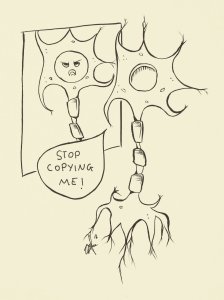
Mirror Neuron, get it? (Illustration by I.C.J.)
Before jumping into how mirror neurons became related to autism, it is important to note that while these mirror neurons were discovered in monkeys, researchers have yet to prove its existence in humans. While indeed, there is evidence of a mirror system in humans, we have only observed the mirror neuron itself directly in monkeys through recordings of electrical signals in single neurons. Conversely in humans, we have only observed indirect evidence through imaging analyses and EEG (mu waves) over an area of millions of neurons; therefore making the isolation of mirror neuron activity difficult.
In 2006, mirror neuron (MN) theory researcher Marco Iacoboni, postulated that a reduction of MN activity may explain other symptoms of autism besides social ability. He suggested that the MN theory could explain motor deficits in autism as mirror neurons are located in the motor areas essential for action selection and planning. If this is the case then the theory could also potentially explain language abnormalities as Broca’s area overlaps the ventral premotor cortex, important for comprehension and action execution. Gosh, if this is true, this theory could ultimately explain nearly every autism symptom! How great would that be now wouldn’t it.
Consequently, a popular supporter and researcher of the MN theory, Vilayanur Ramachandran used EEG to investigate dysfunctional mirror neurons in high functioning autistic children. The Mu-wave component of the EEG, which is active while an individual is at rest, becomes suppressed during voluntary muscle movement and during the observation of another person’s movements. This would make it a suitable non-invasive tool for investigating the MN theory in humans. Ramachandran found, in a sample of 10 autistic children (2005), that while Mu-wave suppression occurred during voluntary movement, it didn’t occur while the children observed the same action in another individual.
Following these findings, several other researchers have also found similar results, feeding into the hype of this theory. Ramachandran went on to claim that “mirror neurons could underlie empathy, inadvertently speeding the evolution of the brain, and thus shaping our civilisation” and all that jazzy-electrifying stuff! However, enticing as it is there is a fundamental flaw in the theory. It does not take into account the fact that we are already able to comprehend actions of others that we are unable to perform ourselves. Imagine watching the gymnastics in the olympics or perhaps a freerunning demonstration. You’ve probably never been able to or will ever be able to perform the same moves, but you still understand what the gymnast or freerunner is aiming to accomplish. It’s the same as understanding how animals fly, crawl and run despite not having the appropriate equipment and motor cells needed to execute these moves. If you are curious about the issues with the MN theory in general, do read “Eight problems with the mirror neuron theory in understanding action selection” by Gregory Hickok (2009).
As for a dysfunctional mirror neuron system in autism? Well, I’ve seen Chris understand perfectly well what characters in cartoons are doing, which he follows by imitating a voice or movement. Empathy-wise I’m not sure but several studies have produced evidence for an intact mirror neutron system in autism. Using the idea that neural activity dissipates after repeated activation from viewing the same movements, Ilan Dinstein and colleagues (2010) found that both his neurotypical (NT) and autism groups had no differences in activation in a series of tasks. A more recent study by Martin Schulte-Rüther and colleagues (2016) utilised facial electromyography in a cleverly designed experiment. Both NT and autism groups were told to smile or frown at a coloured dot placed on top of a face which displayed three different emotions (neutral, smile or frown). Participants were instructed not to look at the face but with the way it was placed, they actually had no choice therefore controlling for the risk that autistic participants tend to avoid looking at faces. Again, no differences were found between both groups and the authors concluded that basic motor mimicry was intact (mirror system) in autism and also that an explanation for social/emotional deficits must be investigated in other areas such as noisy neural networks and cortical hyperexcitability.
.
